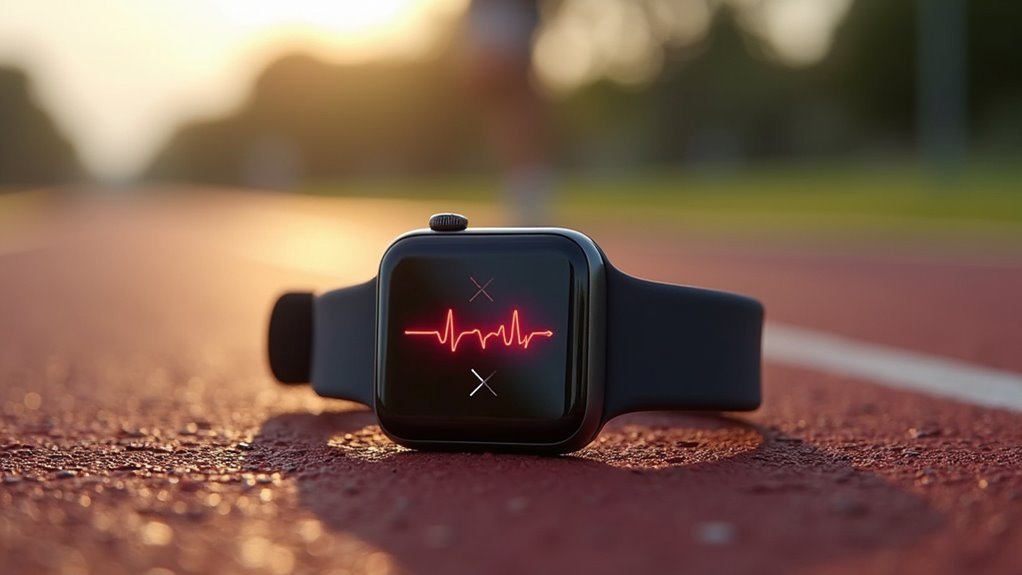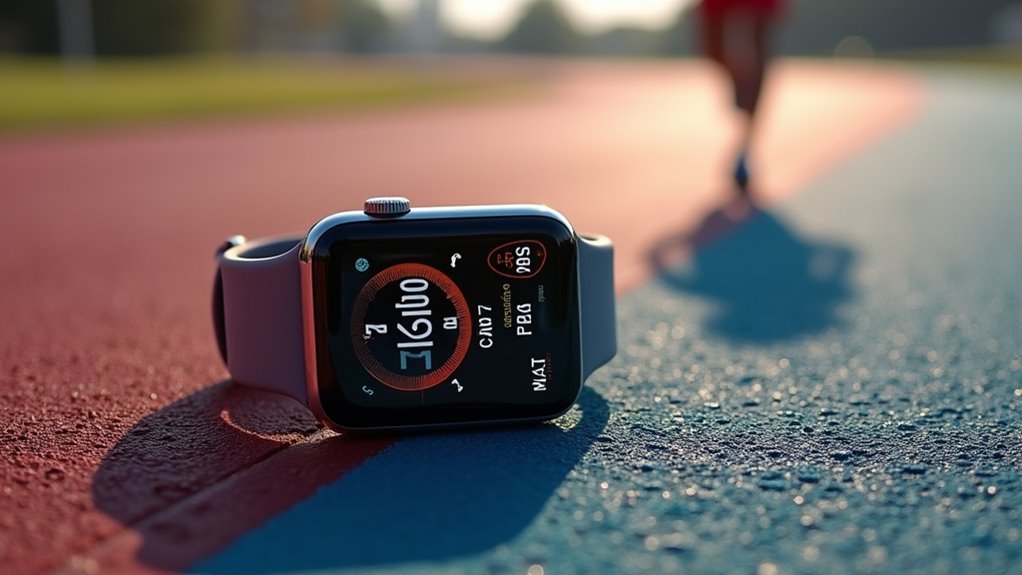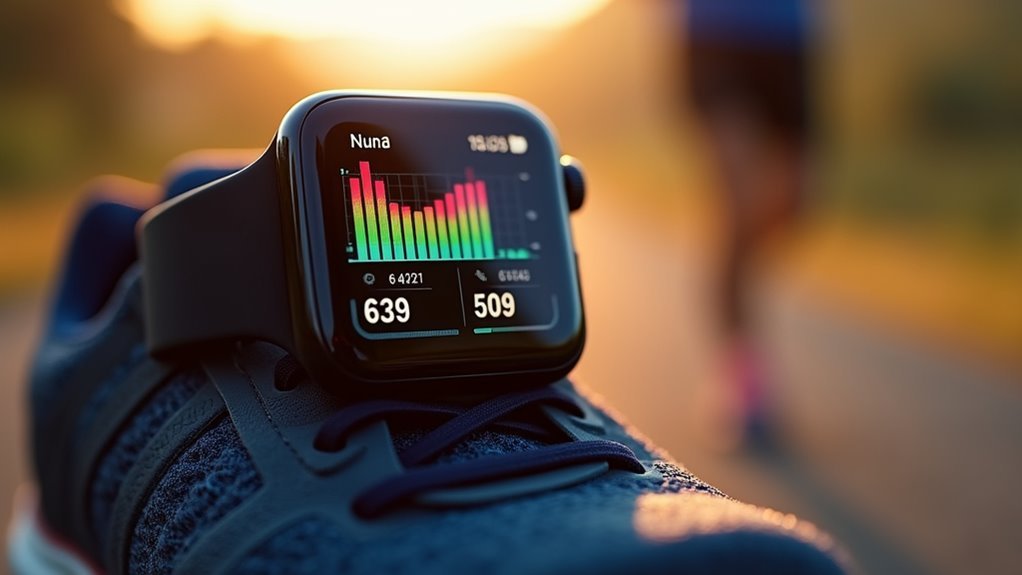Your Apple Watch provides seven essential running metrics: real-time heart rate monitoring with 100% accuracy within 10 bpm at moderate speeds, rolling mile pace tracking for immediate feedback, GPS distance measurement that can deviate up to 10 meters in urban areas, running cadence analysis, advanced ground contact time and vertical oscillation data, battery life lasting 12-18 hours during GPS workouts, and workout data that fragments when pauses occur. Understanding each metric’s limitations will maximize your training effectiveness.
Real-Time Heart Rate Monitoring Capabilities and Accuracy

When you’re pushing through mile splits and monitoring your effort levels, the Apple Watch’s optical heart rate sensor becomes your most critical running companion.
Using green LED lights and photodiodes, it detects blood flow changes in your wrist capillaries with impressive precision during low- to moderate-intensity runs, achieving near-zero mean bias.
However, you’ll notice accuracy declining as your pace increases. While the Apple Watch Series 2 demonstrated 100% accuracy within 10 bpm in clinical studies, real-world running presents challenges.
At faster speeds, the proportion of accurate readings drops considerably. During recovery periods, you can trust the readings remain highly reliable.
The sensor’s frequency and sample rate are specifically optimized for movement, making it superior to basic fitness trackers for serious runners. Many runners report sporadic inaccuracies where readings can spike dramatically during runs, sometimes showing heart rates of 180 BPM when conversational pace suggests rates closer to 135 BPM.
Rolling Mile Pace Tracking for Immediate Performance Feedback
Rolling mile pace tracking transforms your Apple Watch into a real-time performance coach that helps you make instant pace adjustments during your runs.
You’ll get immediate feedback on whether you’re hitting your target pace, allowing you to speed up or slow down before you’ve strayed too far from your goal. However, be aware that the current pace readout may lag behind your actual pace during workouts, which can affect the timing of your adjustments.
This feature becomes essential for training zone optimization, ensuring you maintain the right intensity throughout different segments of your workout.
Real-Time Pace Adjustments
While your Apple Watch provides excellent current pace tracking during workouts, it doesn’t natively offer rolling mile pace adjustments—a feature that would show your pace calculated over the most recent mile rather than just instantaneous speed.
The Workout app displays real-time pace using GPS for outdoor activities and sensor data for indoor runs, but this shows immediate speed rather than smoothed rolling averages.
For more sophisticated pacing feedback, you’ll need third-party solutions like Stryd, which offers real-time environmental adjustments for heat, humidity, and elevation. The Apple Watch can display your current heart rate alongside these advanced metrics, providing comprehensive performance monitoring during your runs.
This app provides rolling adaptability to changing conditions, giving you more precise pacing data than Apple’s stock metrics. You can customize workout views and enable voice feedback, but true rolling mile pace tracking requires external apps to fill this gap.
Rolling Mile Accuracy
Beyond basic pace tracking, you’ll want to understand how accurately your Apple Watch calculates rolling mile pace for immediate performance feedback. While this feature measures your pace over the last mile in real-time, accuracy varies greatly across different watch models and conditions.
You’ll find that Apple Watch Series 3 provides more consistent rolling pace tracking compared to newer models like Series 7, which shows notable inconsistencies. Environmental factors affect accuracy too—open areas typically deliver better GPS signals, though fluctuations still occur on tracks versus sidewalks.
Common issues you’ll encounter include lagging displays that don’t reflect your current speed and inaccurate splits between segments. Recent app updates have caused some users to experience sync problems and measurement discrepancies that affect rolling mile calculations. Calibrating your watch and keeping watchOS updated can improve performance, but discrepancies between your Apple Watch data and third-party apps like Strava remain common.
Training Zone Optimization
Since your Apple Watch calculates rolling mile pace in real-time, you’ll get the most value by pairing this data with optimized heart rate training zones for immediate performance feedback.
Your watch uses heart rate zones to measure intensity levels during workouts, calculated based on your health data. You can manually edit zones 2, 3, and 4 for better accuracy by accessing Workout settings on your watch or companion app.
During cardio-focused workouts like outdoor runs, real-time feedback shows your current heart rate zone and time spent in each zone. This helps you adjust intensity immediately rather than waiting until post-workout analysis. You can rotate the Digital Crown to easily view your heart rate zone display during active workouts.
Consistently tracking workouts refines your training zones over time, making your sessions more efficient while preventing burnout through balanced training across different intensity levels.
GPS Distance Measurement Precision and Signal Loss Problems
GPS accuracy represents one of the most significant challenges you’ll face when tracking runs with your Apple Watch. Your device can experience deviations of up to 10 meters, particularly in urban environments with tall buildings that cause signal reflections.
The watch takes discrete GPS samples, which means it might cut corners on routes with frequent turns, leading to distance under-measurement by 2-5%. When paired with iPhone, your Apple Watch can utilize the phone’s more accurate GPS system for improved tracking precision.
Several factors contribute to these accuracy issues:
- Environmental obstacles like buildings and valleys create signal dropouts and reflections
- Device limitations in older Apple Watch models that access fewer satellite signals
- Sampling intervals that miss sharp directional changes during complex routes
You can improve accuracy through regular calibration, choosing open running areas, and considering upgraded models like the Apple Watch Ultra with dual-frequency GPS capabilities.
Running Cadence Analysis and Sensor Limitation Challenges
While cadence tracking on your Apple Watch provides valuable insights into your running form, you’ll encounter accuracy limitations that can affect your training data.
You’ll find that current cadence readings are typically accurate, but average cadence can be off by about 5 steps per minute. The accelerometer technology measuring your movements can be affected by environmental factors, requiring proper calibration for peak performance.
You must configure your Workout View to display cadence metrics, but you’re limited to selecting only five metrics simultaneously. This restriction may prevent you from viewing both current and average cadence together.
Calibration becomes essential for accuracy—you’ll need about 20 minutes of walking or running at normal pace. Some users report discrepancies between in-workout readings and post-workout reports, highlighting ongoing sensor limitations. Checking your watch frequently during runs may reduce accuracy since looking at the device can interrupt wrist movement patterns that the sensors rely on for step counting.
Advanced Metrics Including Ground Contact Time and Vertical Oscillation
Beyond basic pace and distance tracking, your Apple Watch captures sophisticated biomechanical data that reveals the efficiency of your running form.
Ground Contact Time measures how long your foot stays on the ground during each step, while Vertical Oscillation tracks your up-and-down movement. These metrics help identify energy waste and form inefficiencies.
Your watch uses built-in gyroscopes and accelerometers to estimate these measurements, but you’ll need proper calibration through outdoor runs for accuracy.
Running Power provides insights into your energy output, while customizable metric displays let you focus on specific data points during workouts. You can reorder workout views based on your personal preferences to prioritize the metrics most important to your training goals.
- Ground Contact Time optimization: Elite runners typically maintain GCT below 200ms for maximum efficiency
- Vertical Oscillation reduction: Minimizing bounce saves energy and reduces fatigue over long distances
- Real-time feedback: Access live metrics during runs plus extensive post-workout summaries
Battery Life Issues During Extended GPS-Enabled Workouts

Although your Apple Watch delivers impressive running metrics, extended GPS workouts can quickly drain the battery and cut your training sessions short.
The Apple Watch Series 10 provides up to 18 hours of battery life with GPS-only mode, while the Ultra 2 sustains 12 hours during outdoor workouts. However, cellular connectivity becomes your biggest battery enemy, reducing workout time from 6+ hours to just 4-5 hours with LTE active.
You can extend battery life by disabling cellular and relying on your iPhone’s Bluetooth connection, potentially reaching 9 hours of GPS tracking.
Low Power Mode dramatically improves endurance, offering up to 35 hours by reducing sensor frequency. The Ultra 2 can achieve up to 17 hours of outdoor workout time with GPS and LTE when Low Power Mode is activated.
For ultra-long runs, consider external heart rate monitors and minimize screen interactions to maximize your watch’s workout duration.
Data Fragmentation From Workout Interruptions and Pause Functions
When you pause or stop your Apple Watch workout, you’re likely creating data splits that fragment your running statistics without realizing it.
The automatic pause feature doesn’t always activate when it should, missing brief stops at traffic lights or water breaks, while sometimes triggering incorrectly during slow uphill sections.
If you manually stop your workout instead of pausing it, you’ll lose valuable data continuity and create permanent gaps in your running metrics that can’t be easily merged later. Your Apple Watch tracks heart rate and other metrics in real-time during workouts, making these interruptions particularly disruptive to the accuracy of your overall performance data.
Automatic Pause Accuracy Issues
While the Apple Watch’s auto-pause feature promises to improve workout accuracy by excluding stopped time from your data, it frequently creates more problems than it solves.
You’ll find that roughly one in five users experience unexpected pauses during uninterrupted movement, with the feature incorrectly detecting stops every 10-15 seconds. This creates significant data fragmentation that undermines your workout metrics.
The issues stem from several factors that affect sensor accuracy:
- Wrist placement problems – loose straps or improper fit cause sensor misreads
- Skin characteristics – tattoos and certain skin types interfere with wrist detection
- Workout types – elliptical and interval training trigger more false pauses than steady-state activities
You can minimize these problems by tightening your watch strap and keeping your watchOS updated. Additionally, regular calibration sessions can improve the Apple Watch’s ability to accurately detect movement patterns and reduce false pause triggers.
Manual Stop Data Gaps
Beyond automatic pause malfunctions, manually stopping or pausing your Apple Watch workout creates even more problematic data gaps that can fragment your entire running session. When you accidentally press the screen or digital crown, you’ll inadvertently pause or stop tracking, leading to incomplete records. These interruptions split your aggregated data, making complete statistics nearly impossible to view in apps or dashboards.
| Issue | Impact | Workaround |
|---|---|---|
| Accidental stops | Session splits into multiple files | Use workout lock feature |
| Manual pause gaps | Missing GPS/heart rate data | Avoid unnecessary pausing |
| Data fragmentation | Broken trend analysis | Third-party merging apps |
| Export complications | Separate CSV/XML entries | Manual data reconciliation |
| Metric drops | Pace/cadence inconsistencies | Review data post-workout |
You’ll need third-party apps to merge fragmented sessions since Apple’s native apps lack this functionality. For comprehensive analysis, you can export data to Excel format through the Health app, though built-in software provides limited long-term analysis options.
Frequently Asked Questions
Can Apple Watch Running Stats Sync With Third-Party Fitness Apps Like Strava?
Yes, you can sync Apple Watch running stats with Strava through Apple Health. You’ll need to authorize data sharing in Strava’s settings, and it’ll automatically upload your recent workouts including distance, time, and routes.
How Often Should I Calibrate My Apple Watch for Better Running Accuracy?
You’ll need initial calibration when setting up your watch, then recalibrate only when your fitness level, running style, or body measurements change considerably. Most users don’t need frequent recalibration.
What’s the Proper Wrist Placement for Most Accurate Heart Rate Readings While Running?
Place your Apple Watch on the top of your wrist with a snug strap that doesn’t move during running. Guarantee continuous skin contact and avoid placing it over tattoos for ideal heart rate accuracy.
Do Cellular Apple Watch Models Provide Better Running Features Than Gps-Only Versions?
Cellular Apple Watch models don’t provide better core running features than GPS-only versions. You’ll get identical GPS accuracy and heart rate monitoring, but cellular offers independent streaming and longer battery life disadvantages.
How Does Apple Watch Running Power Metrics Compare to Dedicated Running Pods?
Apple Watch running power closely matches dedicated pods like Stryd during steady running, but you’ll miss detailed metrics like form power and live lap data that specialized pods provide.
In Summary
You’ll find Apple Watch offers impressive running features like real-time heart rate monitoring and rolling pace tracking, but you’re also dealing with genuine limitations. GPS signal drops, sensor accuracy issues, and battery drain during long runs can frustrate your training goals. Despite data fragmentation problems and missing advanced metrics found in dedicated running watches, you’ll still get solid performance feedback that’ll help improve your running when you understand these constraints.





Leave a Reply